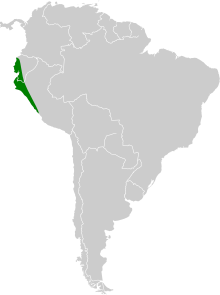Fraternal fruit-eating bat
| Fraternal fruit-eating bat | |
|---|---|

| |
| Scientific classification | |
| Domain: | Eukaryota |
| Kingdom: | Animalia |
| Phylum: | Chordata |
| Class: | Mammalia |
| Order: | Chiroptera |
| Family: | Phyllostomidae |
| Genus: | Artibeus |
| Species: | A. fraterculus
|
| Binomial name | |
| Artibeus fraterculus Anthony, 1924
| |

| |
| Synonyms | |
|
Artibeus jamaicensis fraterculus Cabrera, 1958 | |
The fraternal fruit-eating bat (Artibeus fraterculus) is a species of
It is a generalist frugivore, feeding on a variety of fruit and supplementing its diet with insects. It breeds in both the wet and dry season, with parturition (birth of young) peaking in February and May. The only known predator is the barn owl, although it may also be hunted by other birds of prey and the spectral bat. It is parasitized by species of streblid bat flies, mites, and protozoans.
The fraternal fruit-eating bat is listed as being a species of
Taxonomy and systematics
The fraternal fruit-eating bat was first described in 1924 by Harold Elmer Anthony on the basis of a specimen collected at an altitude of 2,000 ft (610 m) in Portovelo, el Oro, Ecuador. It was subsequently considered a subspecies of Jamaican fruit bat (Artibeus jamaicensis), until it was raised to species level again by Karl Koopman in 1978 on the basis of morphological data.[2]
The generic name Artibeus is from the
The fraternal fruit-eating bat is one of 12 species in the genus Artibeus. Within the genus, it was historically considered to be part of the Jamaican fruit bat complex. Instead, studies of
Description
The fraternal fruit-eating bat is the smallest species of large Artibeus (a group that also includes the Jamaican fruit bat,
The head is large with a relatively big
The fraternal fruit-eating bat's facial lines are faint and hardly visible, and some individuals have lower stripes that are unnoticeable. Contrastingly, Anderson's fruit bats have thin, clearly visible facial lines, while the great fruit-eating bat has prominent facial lines. The flat-faced fruit-eating bat also has conspicuous facial lines.[2]
Ecology
Diet
The fraternal fruit-eating bat is mainly a
Breeding
The fraternal fruit-eating bat is a seasonal breeder which breeds twice a year in both the wet and dry season. Although it gives birth in both seasons, it peaks during February and May. Pregnant females have also been reported in October and November, while lactating females have been reported in July and November. During the dry season, males with descended gonads and females with developed nipples have been reported in September.[2]
Predation
The only known predator of the fraternal fruit-eating bat is the barn owl. However, it may also be predated by other species of owls and the bat falcon. Another possible predator is the spectral bat.[2]
Parasites
The fraternal fruit-eating bat is parasitized by the streblid bat flies Aspidoptera phyllostomatis, Megistopoda aranea, Metelasmus pseudopterus, Speiseria ambigua, Strebla guajiro, and Trichobius joblingi and the mite Periglischrus iheringi. It is also parasitized by the protozoan Trypanosoma cruzi.[2]
Echolocation
The starting
Distribution and habitat
The fraternal fruit-eating bat is found in
It inhabits forests, disturbed habitats, and agricultural and urban areas. It is most frequently found in mangrove forests, arid scrubland, and deciduous and semideciduous forests. It is also uncommonly found in wetter habitats. It has been recorded in humid montane scrub in Loja, Ecuador. It occurs at elevations between 0–2,145 m (0–7,037 ft).[2]
Throughout most of its range, the fraternal fruit-eating bat is
Status
The fraternal fruit-eating bat is listed as being a species of
References
- ^ . Retrieved 16 November 2021.
- ^ ISSN 0076-3519.
- .
- ISBN 978-1-4614-7396-1, retrieved 2021-10-10
- ^ Patten, Donald Richard (1971). "A review of the large species of Artibeus (Chiroptera: Phyllostomatidae) from western South America" (PDF). Texas A&M University Publishing.

